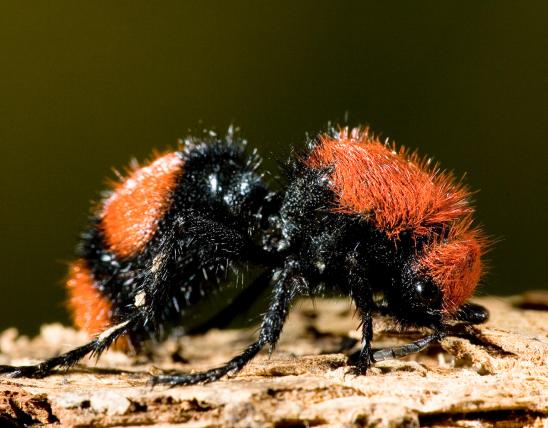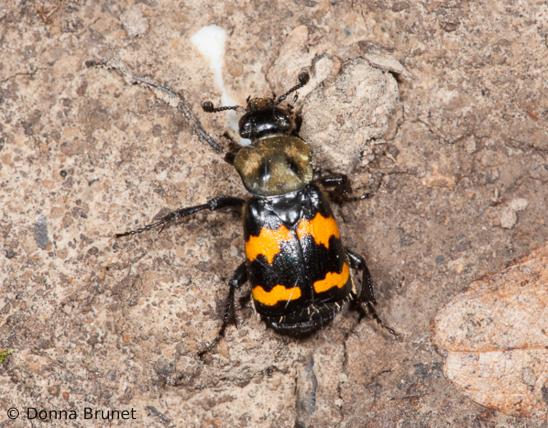
Eastern carpenter bees somewhat resemble bumblebees but have a noticeably black, shiny abdomen. Bumblebees, although about the same size and shape, have a noticeably fuzzy abdomen, usually with a prominent yellow band across it. You can also distinguish the two by their behaviors: Carpenter bees are rather solitary and excavate their nests in wood. A small pile of sawdust beneath a hole about ⅜ inch in diameter is a clue to their presence.
Learn more about carpenter bees and other apid bees (family Apidae) on their family page.
Length: about ¾ to 1 inch.

Statewide.
Habitat and Conservation
Often seen foraging nectar from flowers. Primarily a forest species that bores nest holes vertically up into wood, this is the only large carpenter bee in Missouri. It prefers coniferous wood and often reuses old nests, cleaning them of debris and enlarging them. Nest plugs and cell partitions are made of wood chips; cell walls are unlined.
Food
Adults feed on nectar from flowers, sometimes biting a hole in the base of the petals to "rob" the nectar without pollinating. They do pollinate many flowers, however, including passionflowers (maypops). The female provisions her nest tunnels with nectar and pollen, then lays eggs on this food, which nourishes the young as they develop. Carpenter bees are busy provisioning their nests in the spring and summer.
Status
As with many members of the ants, bees, and wasps group, the females of this species are capable of stinging when molested. The males lack stingers altogether. The males often startle people with their aggressive-looking territorial hovering, but although they investigate anything new in their territories, they are only interested in combating rival males. They are uninterested in people.
Life Cycle
Carpenter bee nests are provisioned in the spring and summer. After emerging, the young adults fly and feed briefly before overwintering in the tunnels. Mating occurs the following spring. The white-faced males are often seen at this time hovering in a pendulous, bobbing dance near nests, waiting for females. These males rush to investigate any airborne object — a thrown pebble for example — that comes near them.
Human Connections
Structural damage to timber can result, especially when there are many nests, or when woodpeckers enlarge the holes to feed on the larval or overwintering bees. If you are concerned, consult university extension services for management tips.
Because carpenter bees are important pollinators, some farmers encourage their presence by providing blocks of wood attractive to them.
With a little practice, it is easy to identify male carpenter bees and handle them, since they don't have stingers. This could be a new way to impress your friends and family.
Ecosystem Connections
Carpenter bees are important pollinators for many types of plants.
In nature, their tunneling into soft, dry, rotting wood speeds decomposition, helping to recycle nutrients back into the soil.
Biologists study carpenter bees because their behavior seems transitional between solitary and true social behavior.
One species of bee fly (a true fly that only resembles a bee) makes its living from carpenter bees. The mother tiger bee fly (Xenox tigrinus) hovers around wooden privacy fences, wooden roof overhangs, and similar wooden surfaces, looking for places where a mother carpenter bee is preparing a nest tunnel. The bee fly sneaks in and deposits her eggs where the carpenter bee lays hers. The carpenter bee, unaware that she's being tricked, seals the chamber with what can only feel like a sense of completion. The bee fly larvae eat the carpenter bee larvae.
Just as the nest cavities drilled into wood by woodpeckers become nesting space for other birds after the woodpeckers have moved on, the holes of carpenter bees are often used by other insects that need holes. You might see female wasps carrying paralyzed katydids, spiders, or other prey and stuffing them into holes originally excavated by carpenter bees.














































